By John Black
This article first appeared in the FRAM Journal.1
Among the many distinctive features of Framlingham are the two octagonal Victorian pillar boxes with vertical slits (Figs. 1 & 2). A drawing of these boxes by local illustrator Max Bowman is included in the graphic banner of this website. This type of box was made in 1856 by Andrew Handyside of Derby; in 1857 a horizontal slit was substituted, presumably as a better protection against rain.2 The boxes were ordered by the Post Office’s Eastern District;3 at that time the districts were responsible for ordering and siting letter boxes.
A search at the Post Office Archives in London4 for the years 1856 and 1857 failed to reveal any information about the erection of the boxes, but it was recorded that the postmaster had been “reprimanded” on two occasions; the offence was not stated. However, the Framlingham Weekly News for Saturday June 30th 1883 contained the following item:
Postal Pillar Boxes – For the convenience of the inhabitants, postal pillar boxes have been erected opposite to the Hare and Hounds Inn [former Inn at the top of Double Street], and at the juncture of the Saxtead and Dennington Roads in College Road. A box will also be erected at the Railway Station.
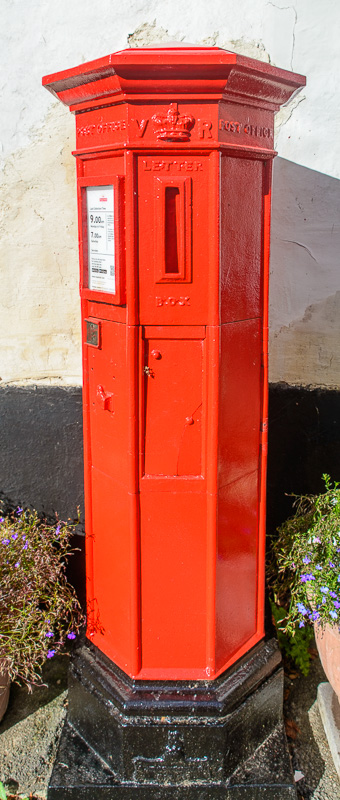
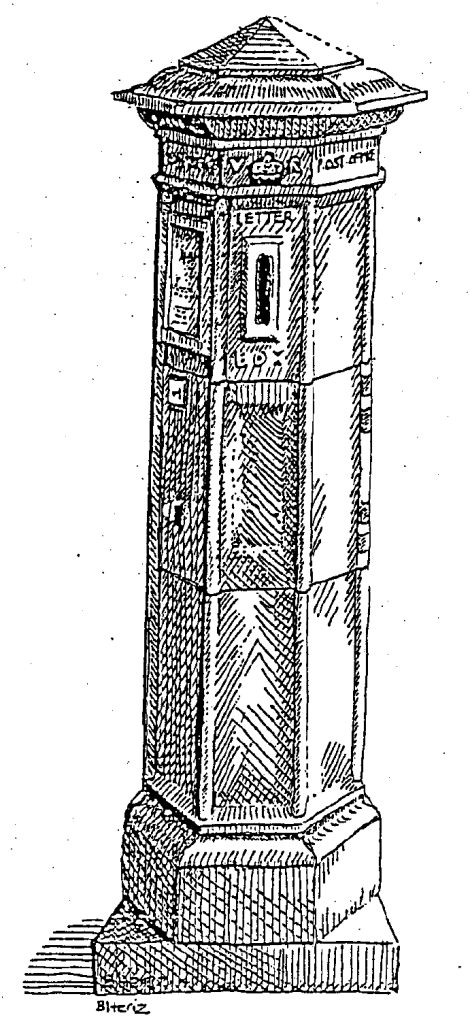
This shows that the two existing boxes are in their original positions. It is not known whether a third box was actually erected at the Station; it certainly no longer exists there. The earliest post boxes were installed in 1852 in Guernsey, at the suggestion of the novelist, Anthony Trollope5. Initially, the boxes were painted in various colours, and it was not until 1884 that they were all Painted red6.
Since the beginning, the convention has been to have the words, in raised lettering, “Post Office” with a crown and the initials or cipher of the reigning monarch; the 1856 design carries the words “Letter Box”, but this was changed in later designs to “Letters” or ” Letters Only”. The exception was the “Anonymous Box”, made between 1879 and 1889 by Handyside; this carried only the maker’s names7. In most designs the maker’s name appears at the base of the box.
The rarest boxes were those put up during the reign of Edward VIII; nearly 150 of these are still in use8. The most unusual and possibly unique pillar box is at the gates of the Royal Hospital, Chelsea. This is placed in the middle of a row of iron railings and has a slit on each side, enabling letters to be posted from within the hospital grounds when the gates are closed, and also from the street.
Over the years the design of pillar boxes has changed, as have the manufacturers. Various types of octagonal boxes were replaced in 1876 by the familiar cylindrical box with a slightly domed top and overhanging serrated edge9. In 1980 the cylindrical type was superseded by what can only be described as a phallic shape, the “K type” of box. This was followed by a rectangular box. In big cities oval boxes with two slits are widely used; originally for “Town” and “Country”, they are now for first and second class letters.
Though Handyside was one of the earliest firms to have a contract with the Post Office, the best known firm is the Carron Iron Works at Falkirk in Stirlingshire, founded in 1759 and closed in 1982. The firm specialised in cast iron goods from guns used at Trafalgar and in the Peninsular War, to grates and enamelled baths10. The firm gave its name to a gun, the carronade (a short cannon of large bore), and to Carron Oil (a mixture of linseed oil and limewater) used for the treatment of burns and scalds; in 1889 Patrick Tully, a moulder at the works, was treated with Cairon Oil for a burn on his foot11. The firm also made the telephone kiosks to a design by sir Giles Gilbert Scott, inspired by Sir John Soane’s tomb in Old St. Pancras Churchyard in London.
The site of the Carron Company works on the River Carron was chosen because of its proximity to deposits of iron ore, coal and limestone, and a river with a good fall of water12. For the same geological reasons other foundries were set up in the same area, McDowall, Steven & Co. Ltd., at Falkirk and the Lion Foundry at Kirkintilloch. There appears to have been only one major manufacturer in London, the firm of w. T. Allen &Co.
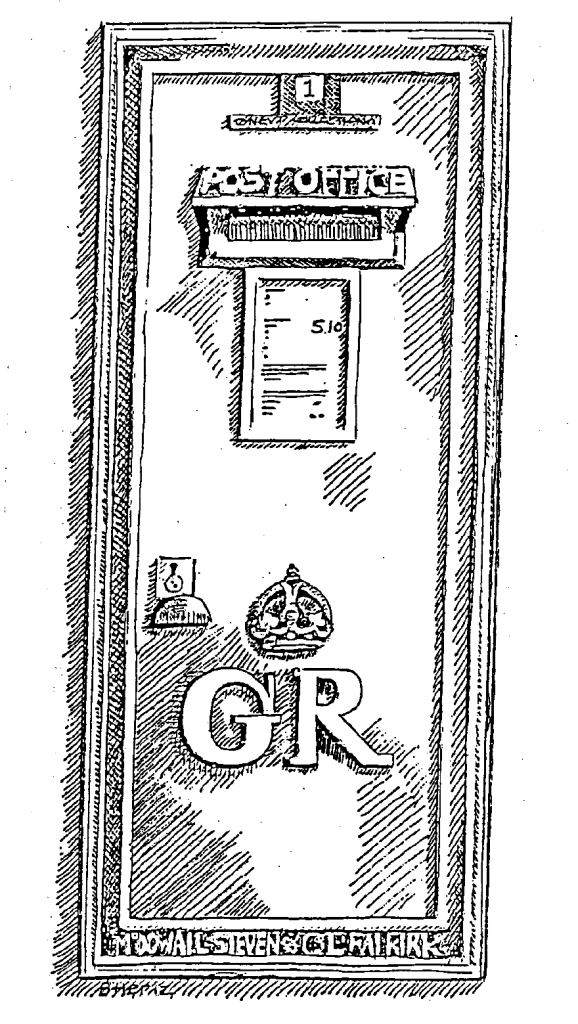
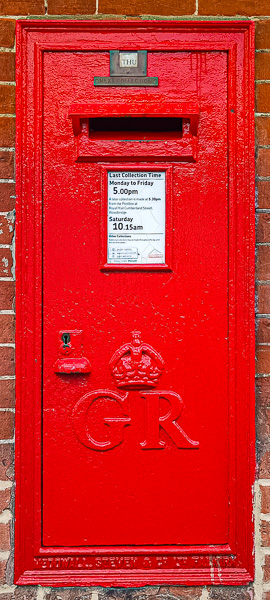
Apart from the two octagonal boxes there is one other Victorian letter box in Framlingham; this is a wall box by W.T. Allen now held in the Lanman Museum; identical boxes, but better preserved, are at Ipswich and Stowmarket Stations. There are two EIIR pillar boxes in the town, one in Market Hill by the Carron Company, and the other marked “Machan Eng. Scotland”, at the junction of Pembroke Road and Saxtead Road. The oldest wall box still in use is at the Post Office; this is marked GR – George V – (Figs. 3, 4 & 5) and was made by McDowall, Steven and Company. There are two lamp boxes (so called because they were originally designed to be fixed to lamp posts), both EIIR. One is in Station Road, facing Victoria Mill Road, and made by the Carron Company; the other is also in Station Road about half a mile to the south; this is made of welded steel and carries no maker’s name. An example of the “K type” phallic design by the Lion Foundry is near the main car park at Woodbridge. There is a box of the rectangular design, again by the Carron Company, near the Post Office at Wickham Market.
It is hoped that this brief description of letter boxes will stimulate the interest of members of the society in one of the most useful and intriguing pieces of our street furniture.
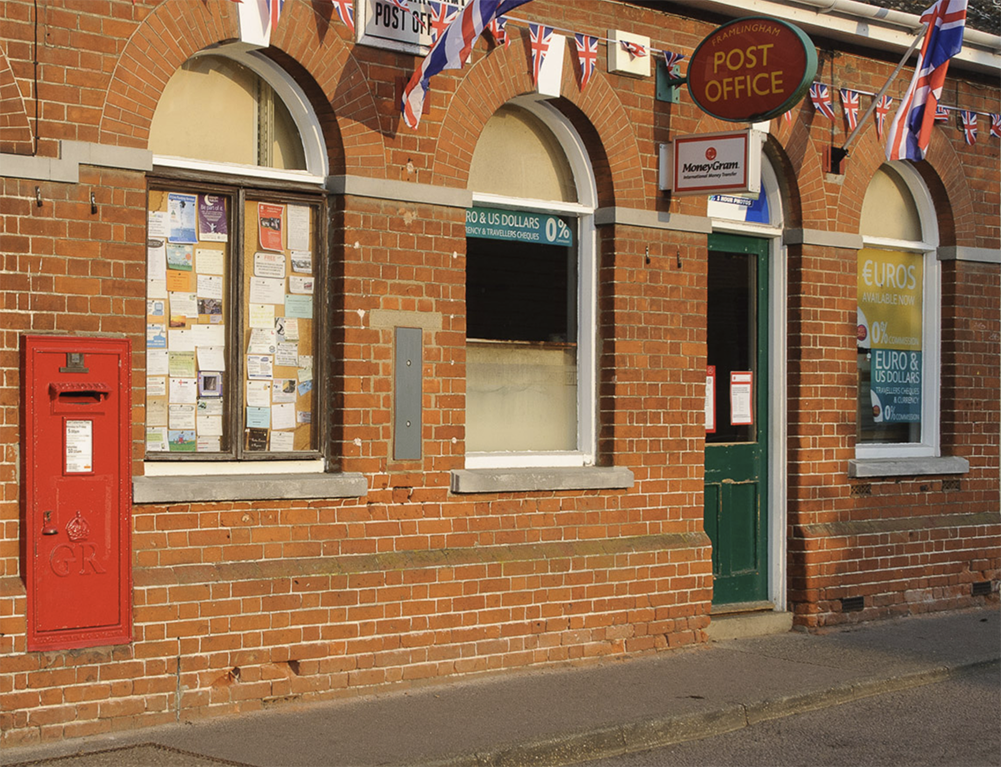
Acknowledgements
I am grateful to Canon David Pitcher and Mr. M. V. Roberts for their help in tracing the reference in the Framlingham Weekly News.
Footnotes
- FRAM Journal Series 4 No.2, December 2001. See Newsletters and Journals. ↩︎
- Robinson, M. Old letter boxes (Princes Risborough, Shire publications,1987) p. 6 ↩︎
- Ibid.p. 5 ↩︎
- Now part of the Postal Museum. See https://www.postalmuseum.org/collections/the-archive/. ↩︎
- Ibid. p. 4 ↩︎
- Lister, R.Decorative cast ironwork in Great Britain (London, G. Bell and Sons Ltd.,1960), p. 210 ↩︎
- Robinson M. op. cit. p.11 ↩︎
- Ibid. p.17 ↩︎
- Ibid. p.11 ↩︎
- Watters, B. Where iron runs like water! A new history of Carron Ironworks, 1759-1982. (Edinburgh, John Donald Publishers Ltd.,1998) pp.177-181 ↩︎
- Ibid. p. 201 ↩︎
- Ibid. pp. 4-5 ↩︎
